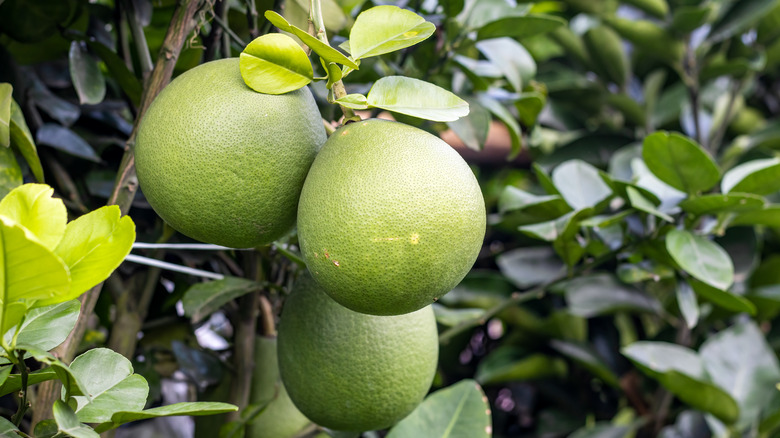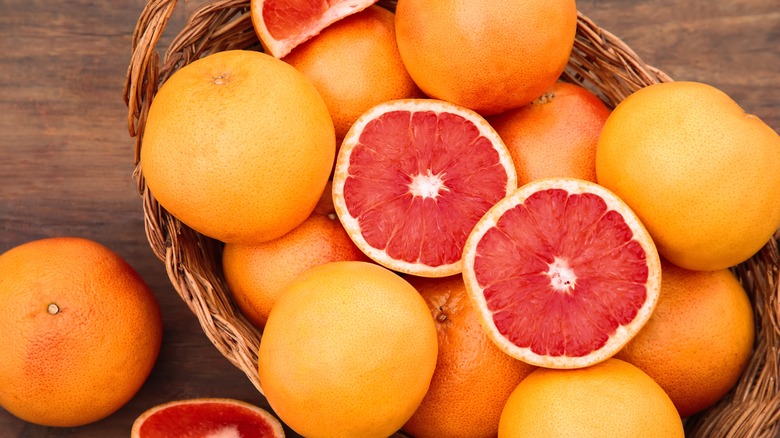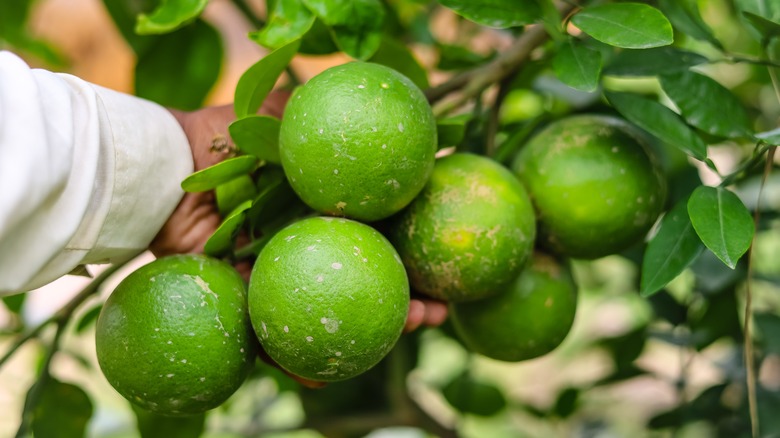What's The Difference Between Pomelo And Grapefruit?
There are all sorts of citrus fruits growing on planet Earth, offering various flavors and properties. In America, the most commonly consumed ones are unquestionably oranges, lemons, limes, and grapefruits — but that's not where the citrus family ends. From the lemon-like Japanese yuzu to the small Chinese kumquat, there are many fruits (and particularly citrus fruits) that are not as ubiquitous in the United States. Right into this discussion comes pomelo, an East and Southeast Asian fruit that is believed to be the ancestor of the grapefruit.
But if grapefruit descended from the pomelo, then what are the differences between the two? There's a bunch, really, and they come down to a variety of factors. Pomelos are huge (even larger than the notoriously chonky grapefruit) and they're green on the outside, rather than yellow-orange. There are also taste and nutrition differences between the two — although they are pretty similar overall, which is unsurprising, given their shared heritage.
The two look totally different, but they taste pretty similar
Pomelo is one of the grandfather fruits of the citrus family, native to South and Southeast Asia and still very popular in nearly every Southeast Asian cuisine. It's widely believed that grapefruits were born from a hybridization of pomelos and oranges in the 18th century, per the University of Florida.
Fortunately, you don't have to have to worry about telling them apart visually from the outside. Grapefruits are big, but pomelos are bigger; they weigh around two to four pounds (and can weigh up to 25 pounds!) and are the size of a small volleyball. Grapefruits, on the other hand, typically weigh around a pound. The colors of their peels aren't the same, either; while grapefruits have yellow-to-yellow-orange peels, pomelos typically have green-to-yellow peels. Their shape is different, too, as grapefruits are round, while pomelos tend to be slightly tapered at one end, similar to an oddly shaped pear.
The crazy thing, though, is that once you actually dig into them, you'd have a much harder time telling them apart. Pomelo flesh not only looks like that of a grapefruit, but there's about the same amount of fruit in one. The reason this is possible is because pomelos have a shockingly thick rind of anywhere from ½ an inch to ¾ of an inch. In terms of taste, they're similar — and have a similar range of flavors, and pomelo also comes in red and white varieties — but pomelo tends to be a sweeter, milder version of that same grapefruit flavor. Pomelo has been described as having a flavor recalling sweet oranges, only slightly less juicy.
There are all sorts of ways to use both pomelo and grapefruit
Grapefruit is a much more versatile ingredient than it's often given credit for; a lot of people hear "grapefruit" and they immediately think of a mouth-puckering bite of citrus pulp. If you're not a fan of directly eating the flesh itself, you can always mellow out the flavors of grapefruit by adding some yogurt, honey, or even salt to the fruit. You can also use them in everything from cocktails to salads to ceviche. Pomelo, meanwhile, can be substituted for grapefruit in anything where you don't want the truly sharp bite of acidic grapefruits.
On top of the subtle flavor differences, there are also a few nutritional differences to keep in mind. Pomelos are significantly higher in calories, iron, fiber, and potassium, though they offer less vitamin A than grapefruits. Like many other citrus fruits, both pomelos and grapefruits are rich in vitamin C, antioxidants, and fiber. One thing to keep in mind with grapefruit is it is known to impact the effects of several common prescription drugs, per the NHS.
Grapefruit is also unquestionably easier to find in America than pomelo — though the latter is much more accessible than it used to be. A lot of grocery stores in major cities sell pomelos now, and you can likely find this fruit at any Southeast Asian grocery store. If you're in a less populated area, though, you might be out of luck. Whichever you pick, trying new foods, especially fruits and vegetables, can be a great starting point for enjoying new gastronomical experiences.


